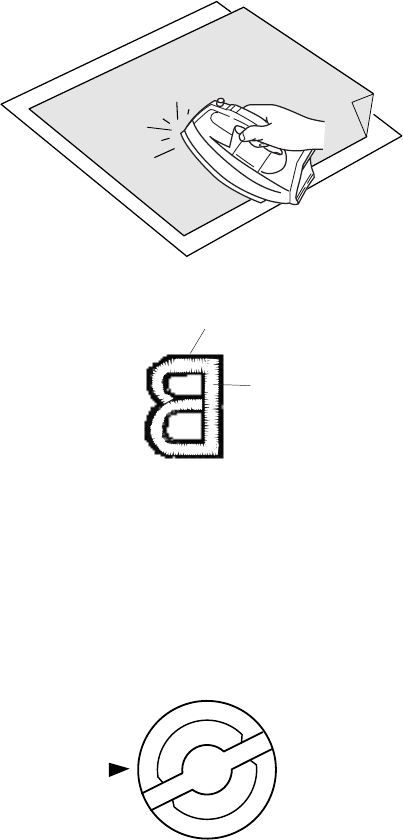
76
1
2
3
2
1
Adhesive (Iron-on) Stabilizer
Place the Wrong side of fabric and the glossy side of
the stabilizer together. Fold up a corner of the
stabilizer and fuse it with an iron.
NOTES:
Fold up a corner of the stabilizer to make it easier to
peel off the excess stabilizer after stitching.
Ironing temperatures vary depending on the kind of
adhesive type stabilizer.
Adjusting the Thread Tension
Balanced thread tension:
A small amount of the needle thread shows on the
wrong side of the fabric.
1 Needle Thread
2 Bobbin thread
When the needle thread tension is too tight:
The bobbin thread shows on the right side of the
fabric.
Reduce the tension by turning the tension dial to a
lower number.
When the needle tension is too loose:
The needle thread forms loops and the stitches look
shaggy.
Increase the tension by turning the dial to a higher
number.
Pressure Dial
For embroidery, set the Pressure Dial at “2”.
Needles
Use size 11 needles for fine fabrics.
For medium to heavy weight fabrics, use size 14 needles.
Stabilizers
To obtain the best quality embroidery, it is important to use stabilizers.
Types of stabilizer
Tear-away Stabilizer is made from a fiber that will tear easily. Use tear-away stabilizers for stable woven fabrics. After
stitching, tear away the stabilizer so that the small portion left in the back of the stitching will not affect the wear.
Iron-on Stabilizer is an adhesive type stabilizer for knits and all kinds of unstable fabrics. Fuse it to the wrong side of the
fabrics with an iron.
Cut-away Stabilizer is a non-woven fabric that does not tear. Cut the excess portion after stitching. Use cut-away
stabilizers for knits and all kinds of unstable fabrics.
Water Soluble Stabilizer will dissolve in water. Use this stabilizer for cutwork or lace embroidery, and also for the right
side of looped fabrics such as towel to avoid loops coming through the embroidery.
Sticky Stabilizer is a sticky paper used for securing a small fabric or work that cannot be secured in the hoop. It is also
used for velvet and other napped fabric that would be permanently marked by the hoop.
Usage:
The stabilizer should be attached to the wrong side of fabric.
More than one layer may be required.
Felt or stable fabrics do not need to be stabilized and you may embroider directly on it.
For firm fabrics, you may place a thin paper under the fabric.
The non-adhesive type should be used when embroidering fabric, which cannot be ironed or for sections, which are
difficult to iron.
Cut the stabilizer larger than the embroidery hoop and set it on the hoop so that the entire piece is fastened with the
hoop to prevent looseness of the fabric.


















